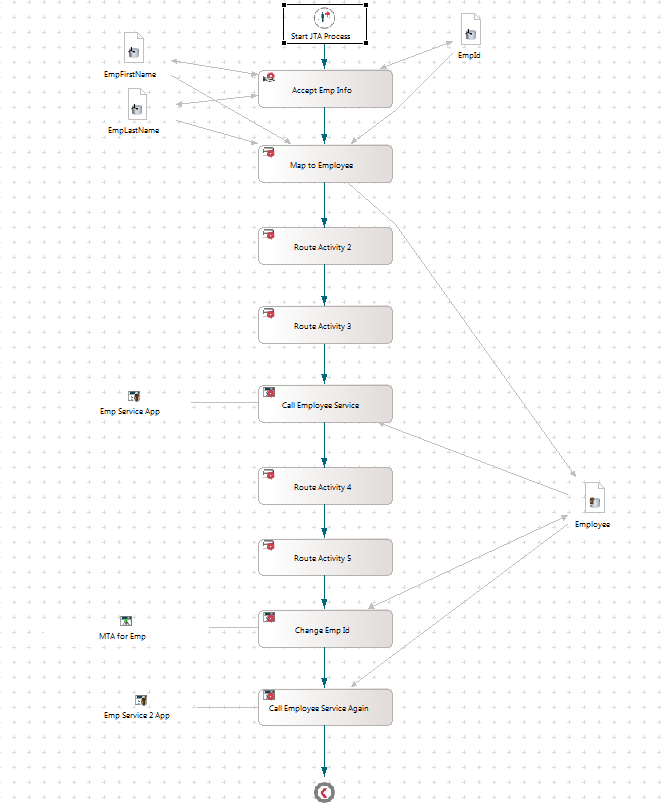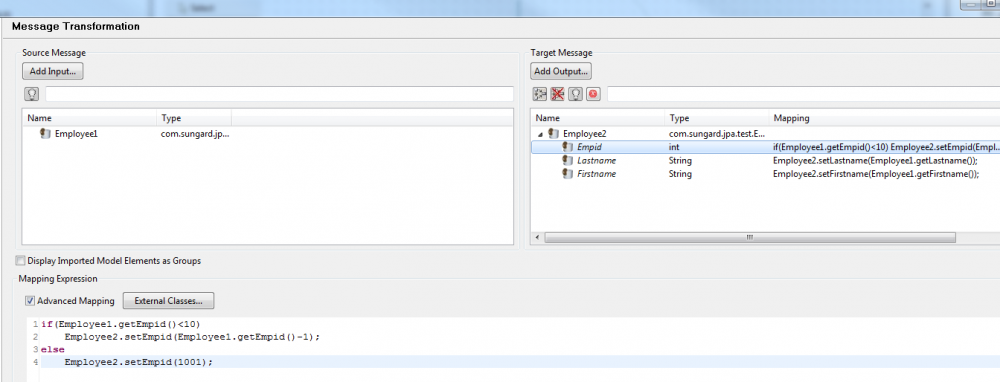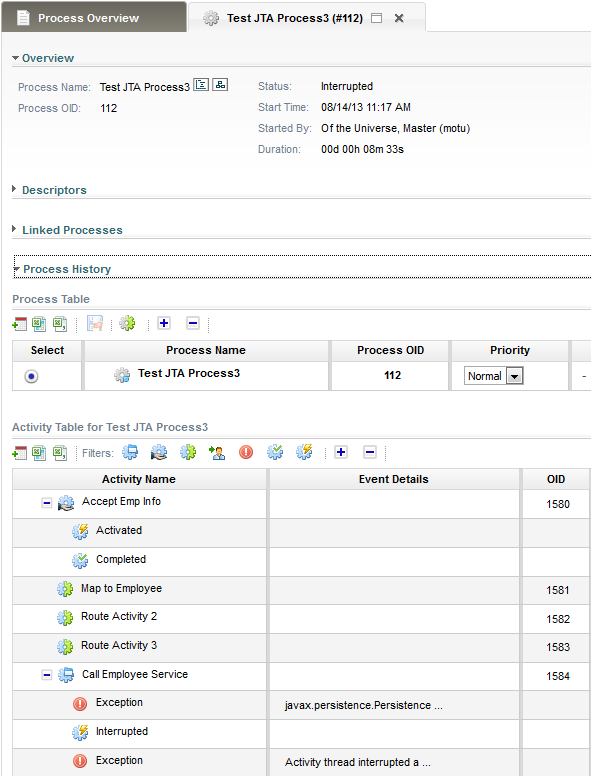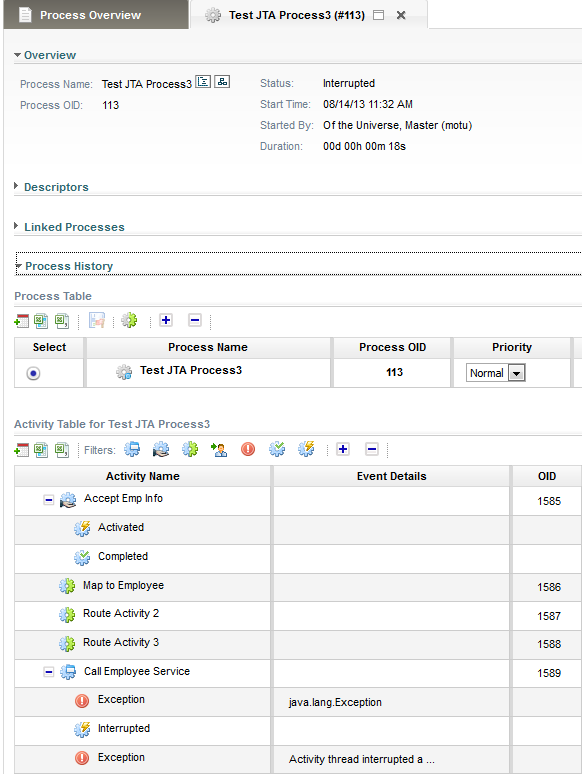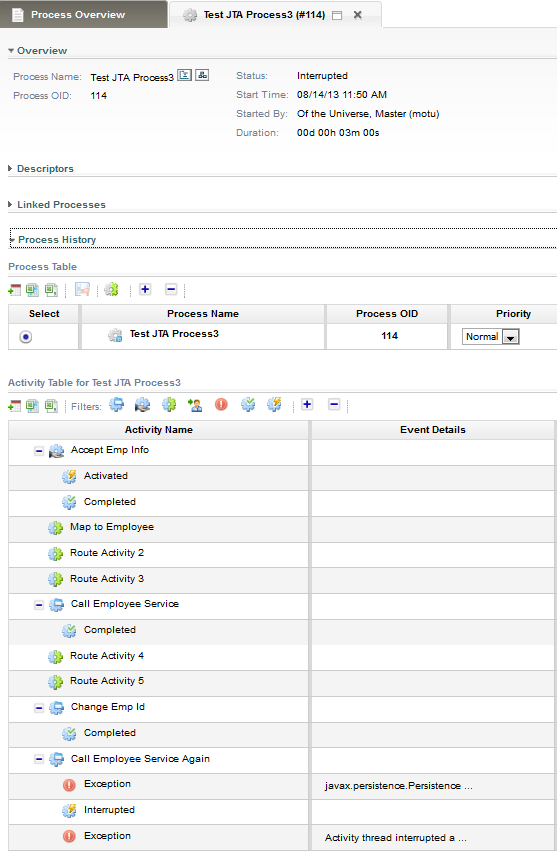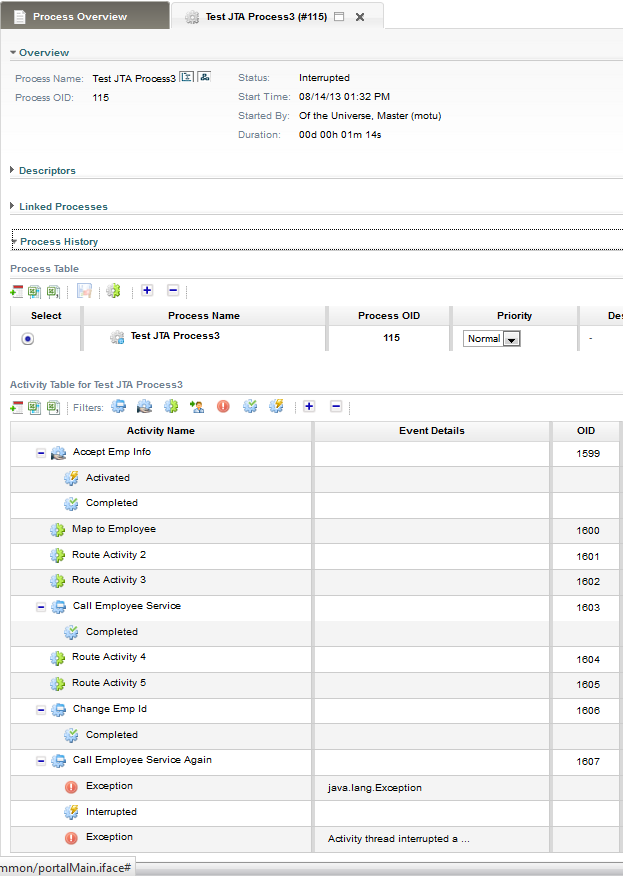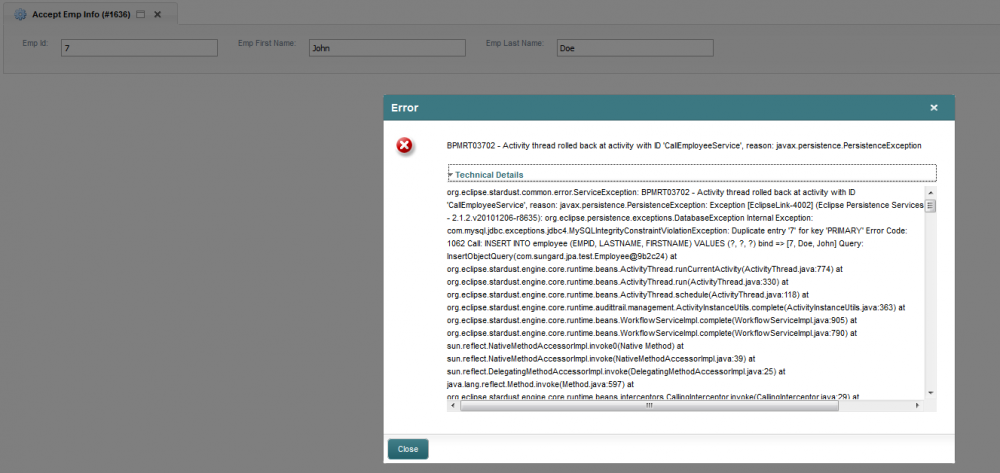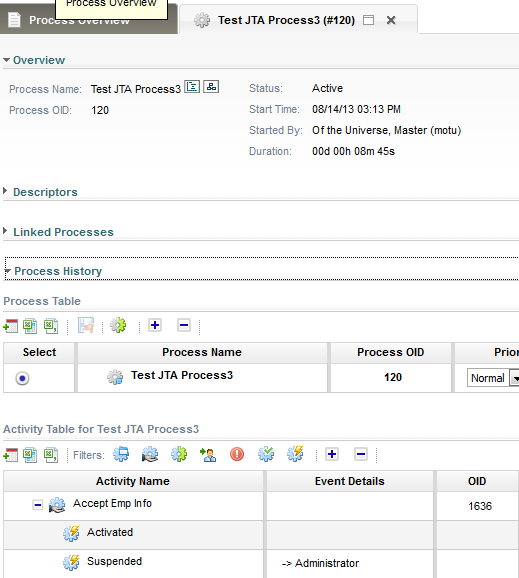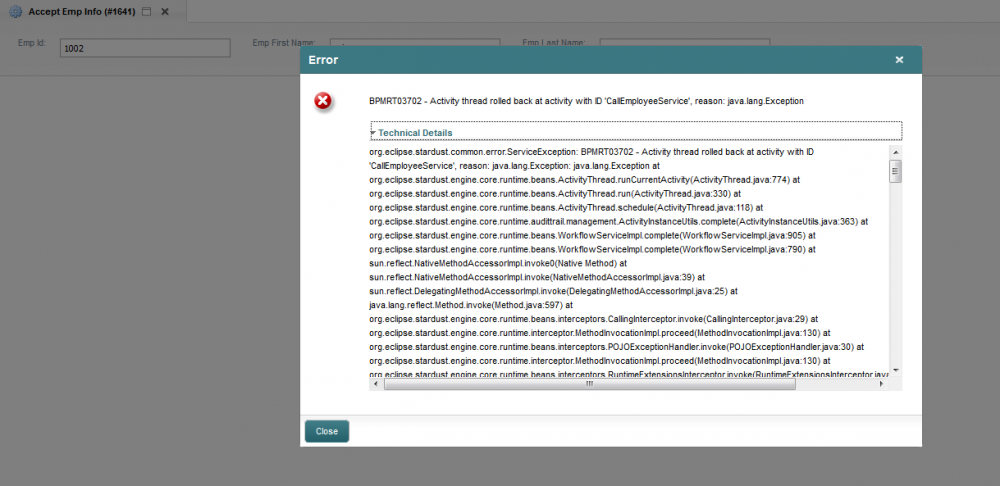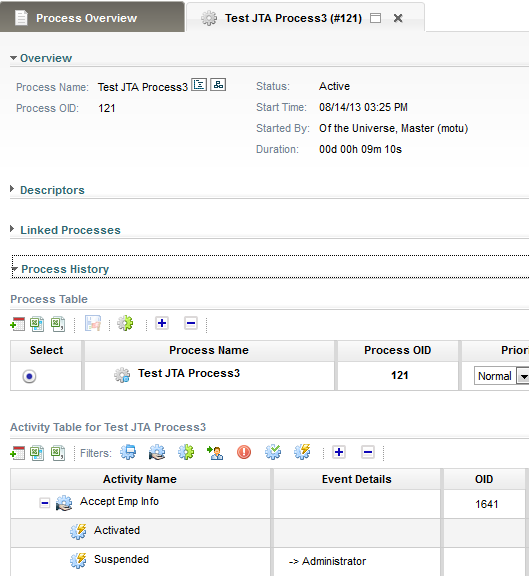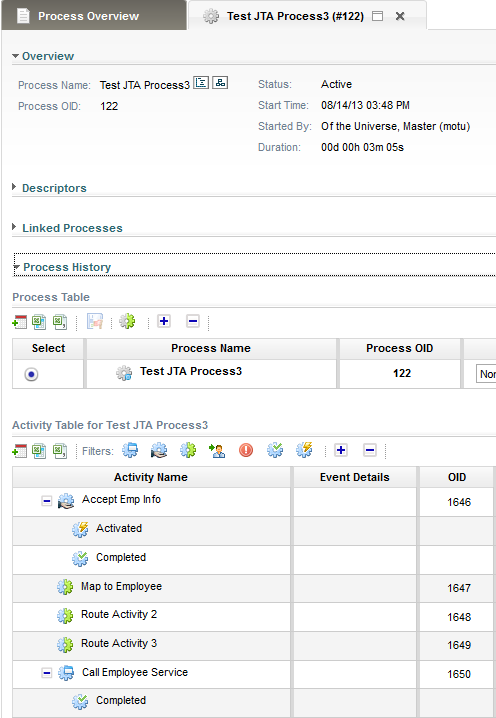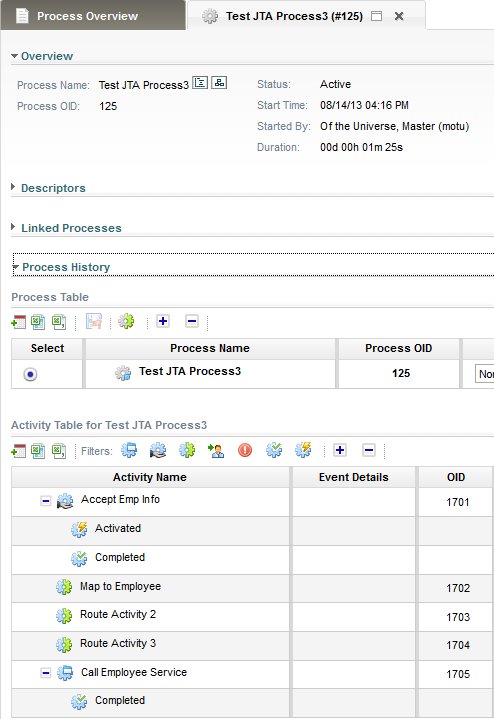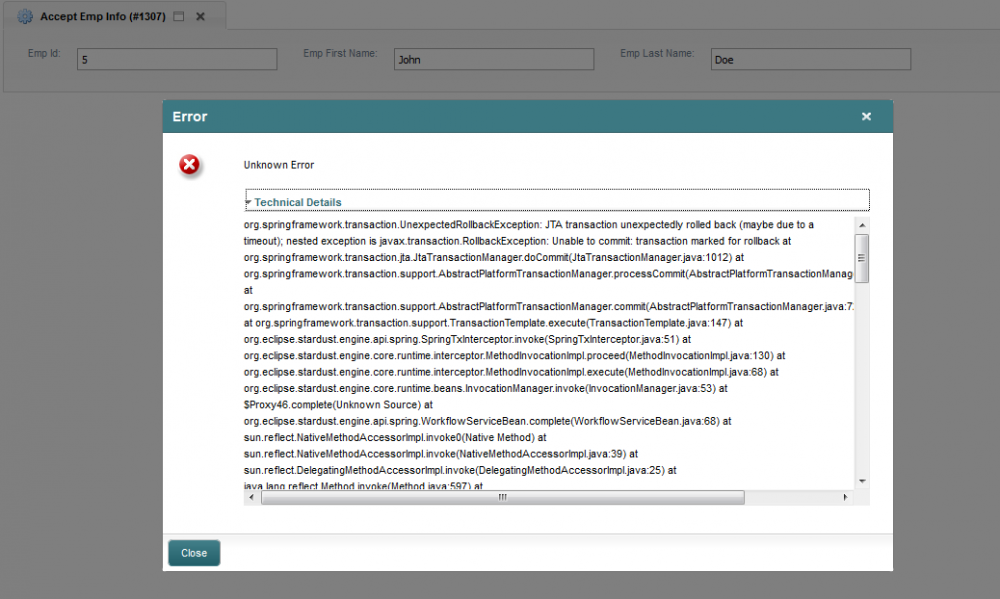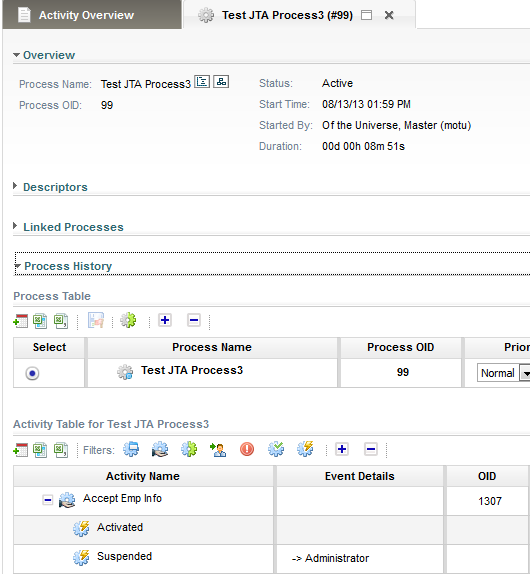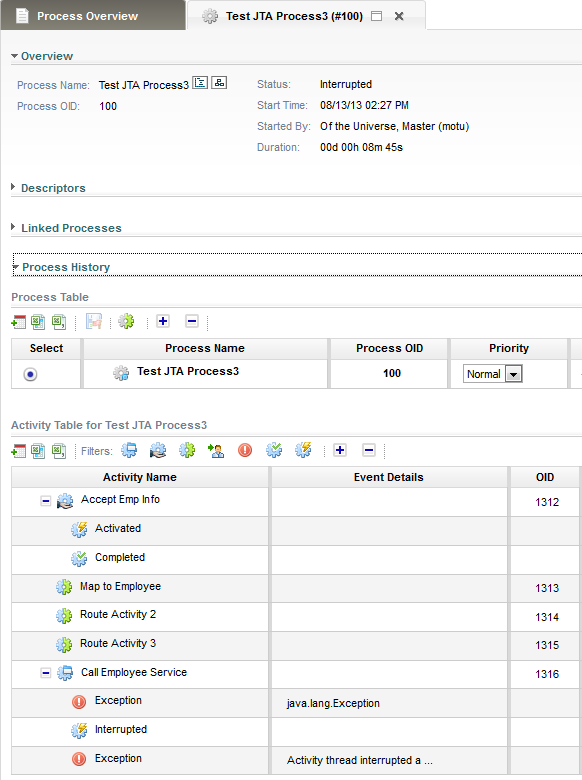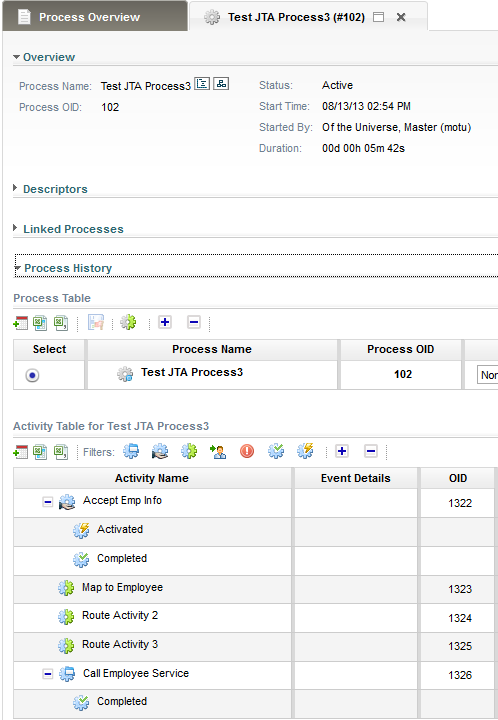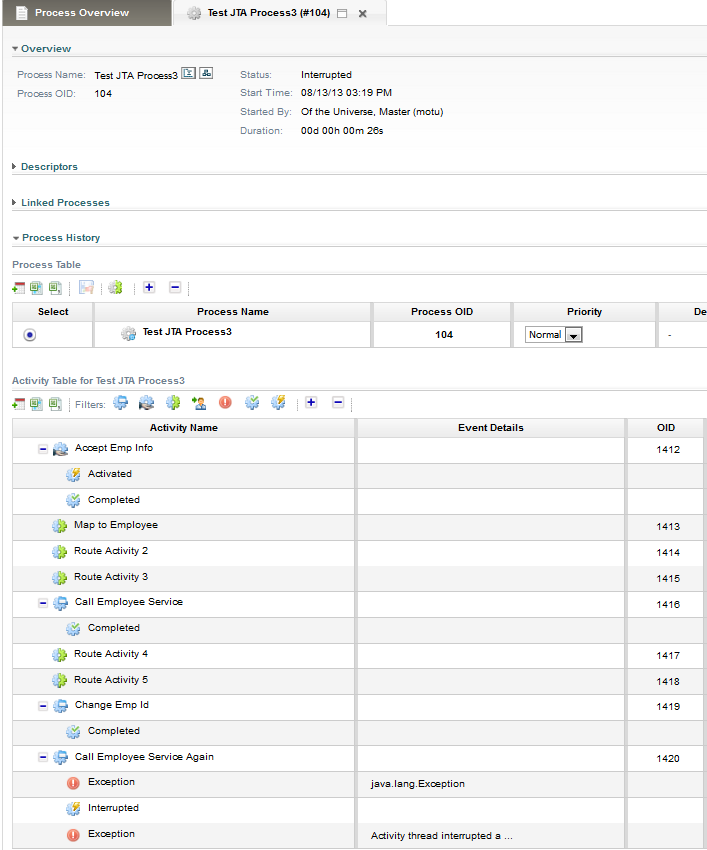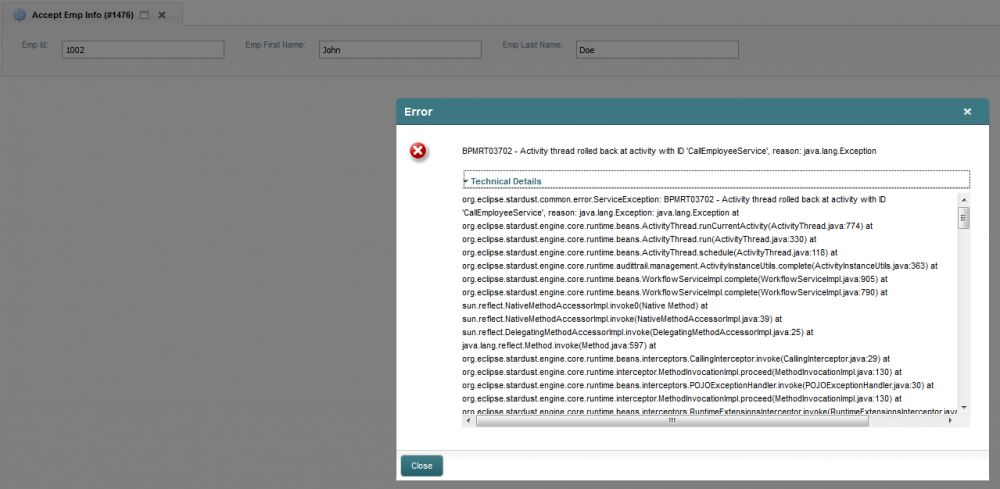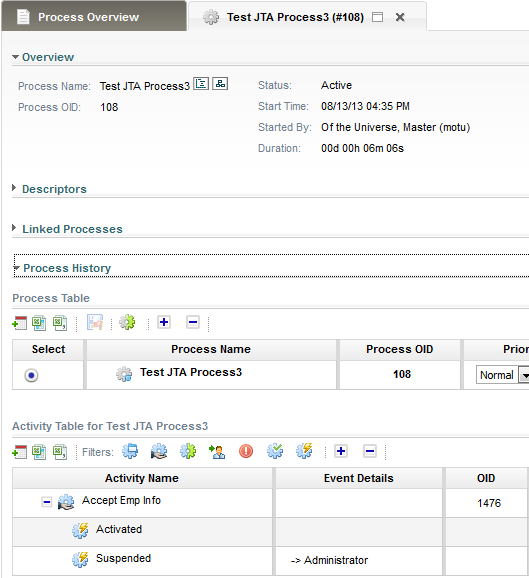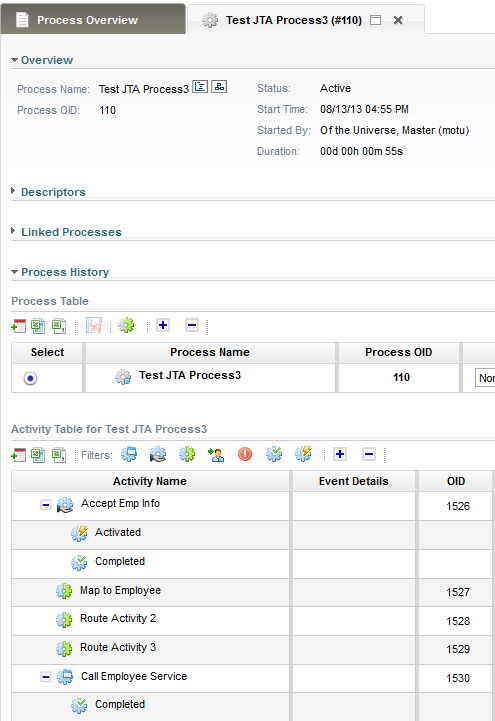Notice: this Wiki will be going read only early in 2024 and edits will no longer be possible. Please see: https://gitlab.eclipse.org/eclipsefdn/helpdesk/-/wikis/Wiki-shutdown-plan for the plan.
Stardust/Knowledge Base/Transaction Management/Understanding Transaction Management in Stardust
Contents
- 1 Introduction
- 2 Scenario
- 3 Process Model
- 4 Employee Service
- 5 Resource Local Transaction Management
- 6 Exception Propagation Mode - never
- 7 Exception Propagation Mode - onRollback
- 8 Exception Propagation Mode - always
- 9 Distributed (JTA) Transaction Management
- 10 Exception Propagation Mode - never
- 11 Exception Propagation Mode - onRollback
- 12 Exception Propagation Mode - always
- 13 Conclusion
Introduction
There is often a requirement to define units of work in a business process. The analyst may want a set of operations to be executed atomically (all-or-nothing). It is important to understand the transaction management process in Stardust to be able to define such execution semantics. It is relevant for the execution of a process to specify where a transaction starts and where it is committed. Specification of where a transaction begins and where it is committed is referred to as transaction demarcation. Transaction demarcation in Stardust is done implicitly and is compliant with the mechanisms of the EJB standard:
Normally, each call to start or continue a process demarcates the boundaries of a transaction. A two-phase commit is performed against all involved data sources after this call returns. If the client submitting this call has already demarcated a transaction, the commit may even be postponed until that point.
This article explores various transaction management scenarios under resource local and distributed transactions contexts involving the Stardust Audit Trail and external database. All artifacts referenced in the article may be downloaded from here. Please refer to the "readme.txt" file contained within the zip for information on how to build, deploy and test the application.
Scenario
We consider a scenario where a Stardust process is kicked off and the user is prompted for some basic Employee information (Emp Id, First Name and Last Name). This data is persisted in a subsequent activity to the external data store. We simulate a TX Rollback exception by generating a PK violation from the database if the Emp Id provided already exists in the database. A Non-TX exception is generated if the Emp Id provided exceeds the value 1000.We execute this process repeatedly for the following conditions:
- Stardust Exception Propagation mode - never, onRollback, always
- Transaction Management configuration - Resource Local, JTA
- Exception type: TX Rollback, Application Exception
- Service Exception - First service call, Second service call
We thus end up testing 24 scenarios.
Process Model
The following process model is considered for the following discussion.
As shown in the model above, we initially accept some user input pertaining to an employee.We can generate exceptions in the Emp Sevice App or Emp Service 2 App under the following conditions:
- TX Exception - If the Emp Id specified for the Employee matches an existing Emp Id in the Employee table, a duplicate PK exception is thrown by the database and results in a TX Rollback. For Emp Service 2 we generate the Emp Id using the following logic in the preceeding MTA activity - If Emp Id entered by user <10, subtract 1 and set that as the Emp Id for the Emp Service 2 invocation, if the Emp Id entered >=10, set the Emp Id to 1001. Emp Id values >1000 result in Application Exceptions as detailed below.
- Application Exception - If the Emp Id specified by the user >1000 it results in an Application Exception on the first sevice invocation. If the Emp Id specified >=10, it results in an Application Exception on the second service invocation.
The message transformation logic for the activity "MTA for Emp" is shown below:
Employee Service
We use two variations of an Employee Service bean to persist the Employee information into the external data store. The first variation is used to test Resource Local transaction management scenarios while the second one is used to test JTA (distributed) transaction management. The two service beans are shown below:
We explicitly invoke the flush() method on the Resource local bean only so that we can study the transactional behavior more easily. The flush forces a database write and any DB exceptions will be thrown right away. Likewise setting the transactional propagation mode to MANDATORY is not a strict requirement. We only do it to ensure that the service method is being invoked within the scope of a global transaction. If it weren't (which shouldn't really be the case with a JTA configuration where the TX has already been initiated by the process engine), we would see a TX related exception prior to the invocation of the bean method.
Resource Local Transaction Management
We analyze the following scenarios:
- Stardust Exception Propagtion Mode - never, onRollback, always
- Exception type: TX rollback, application exception
- Service exception: First service, Second service
Exception Propagation Mode - never
This scenario requires the following entry in carnot.properties
Carnot.Engine.ErrorHandling.ApplicationExceptionPropagation = never
The Stardust documentation states the following:
never - The exception is consumed by the engine and not propagated to the client. The engine sets both, the activity instance and the process instance, to interrupted state and logs the exception to the audit trail. After that, the engine attempts to commit the transaction and stops the execution of the process. The activity (and process) execution may be resumed after running the process instance recovery. Please note that the engine does not check the status of the transaction, and therefore if the transaction is already set to rollback then all the actions performed in this transaction will be lost.
Scenario - TX rollback exception on first service
Although this scenario requires a TX exception to be raised we don't expect the process to roll back since the transaction is not global. Deploy the process model and start the process. Enter an Emp Id that already exists in the Employee table. This will ensure that a PK violation is thrown by the database and result in a TX rollback in the first service invocation but the process instance will only reflect the fact that it has been interrupted. We can verify this by checking the process history as shown below:
The server log appears similar to the following:
11:17:54 INFO - [http-8080-5 ] ActivityInstanceBean - State change for Activity instance 'CallEmployeeService', oid: 1584 (process instance = 112): Application-->Interrupted. 11:17:54 WARN - [http-8080-5 ] AuditTrailLogger - Activity thread interrupted at 'Activity: Call Employee Service', reason: javax.persistence.PersistenceException: Exception [EclipseLink-4002] (Eclipse Persistence Services - 2.1.2.v20101206-r8635): org.eclipse.persistence.exceptions.DatabaseException Internal Exception: com.mysql.jdbc.exceptions.jdbc4.MySQLIntegrityConstraintViolationException: Duplicate entry '5' for key 'PRIMARY'
This Emp Id is not persisted to the Employee database.
Scenario - Application Exception on first service
Since this scenario requires an application exception to be raised we expect the process to be interrupted. Enter the Emp Id 1001. Per the service definition described earlier this ought to result in an application exception. As shown from the process history below, the process is interrupted at activity "Call Employee Service". Note that the exception raised is however different from the one raised in the previous scenario.
The server log shows the following exception:
java.lang.Exception 11:32:39 WARN - [http-8080-4 ] ngBeanApplicationInstance - Failed to invoke Spring Bean method 'addEmployee(com.sungard.jpa.test.Employee)'. java.lang.Exception
This Emp Id is not persisted to the Employee database.
Scenario - TX rollback exception on second service
Since this scenario requires a TX exception to be raised we expect the process to be interrupted at the second service call. The Employee information passed for the first service call ought to be persisted. Enter an Emp Id that is greater by one than the largest current entry in the Employee table (for e.g. if the Employee table currently has Emp Ids 1 thru 5, enter the value 6). This will ensure that the first service call executes without any exception while a PK violation is thrown by the database for the second service call when it tries to insert Emp Id 5.This will result in a TX rollback exception in the second service invocation.As shown below, the process is interrupted at the second service call. Although there is "Fork on Traversal" flag set on the outgoing transition from activity "Call Employee Service" we will see the same behavior even if the flag is turned off. The external data store now shows a new entry for Emp Id 6. The user would not be able to execute both service calls atomically in a resource local TX scenario since each service call is executed in a different transaction. The reader may refer to the model "JTAWorkflowModel2" in the attached zip for an example where the "Fork on Traversal" flag is not used. The process history view in the portal shows the following:
The server log shows the following exception:
11:50:42 WARN - [Thread13 ] ngBeanApplicationInstance - Failed to invoke Spring Bean method 'addEmployee(com.sungard.jpa.test.Employee)'. javax.persistence.PersistenceException: Exception [EclipseLink-4002] (Eclipse Persistence Services - 2.1.2.v20101206-r8635): org.eclipse.persistence.exceptions.DatabaseException Internal Exception: com.mysql.jdbc.exceptions.jdbc4.MySQLIntegrityConstraintViolationException: Duplicate entry '5' for key 'PRIMARY'
The new Emp Id entered by the user is now seen in the external database.
Scenario - Application exception on second service
Since this scenario requires an application exception to be raised we expect the process to be interrupted. Enter the Emp Id 11. This PK does not currently exist in the database. So it would result in the first service call executing without any exceptions. Per the service definition described earlier this ought to result in an application exception only in the second service. As shown from the process history below, the process is interrupted at activity "Call Employee Service Again":
The server log shows the following exception:
13:32:59 WARN - [Thread21 ] ngBeanApplicationInstance - Failed to invoke Spring Bean method 'addEmployee(com.sungard.jpa.test.Employee)'. java.lang.Exception
The Emp Id entered by the user is now seen in the Employee database.
Exception Propagation Mode - onRollback
This scenario requires the following entry in carnot.properties
Carnot.Engine.ErrorHandling.ApplicationExceptionPropagation = onRollback
The Stardust documentation states the following:
onRollback - The behavior depends on the status of the current transaction. If the transaction is set to RollbackOnly, similarly with "always", the engine attempts to log the original exception to the audit trail in a separate transaction and after that, the exception is propagated to the client (re-thrown). If the transaction is not set to RollbackOnly, then it will behave like "never" and it will attempt to interrupt the activity instance and the process instance.
Scenario - TX rollback exception on first service
Although this scenario requires a TX exception to be raised we don't expect the process to roll back since the transaction is not global. Enter an Emp Id that already exists in the Employee table. This will ensure that a PK violation is thrown by the database and result in a TX rollback in the first service invocation but the process instance will only reflect the fact that it has been interrupted. We can verify this by checking the process history which looks similar to the following:
The server log appears similar to the following:
11:17:54 INFO - [http-8080-5 ] ActivityInstanceBean - State change for Activity instance 'CallEmployeeService', oid: 1584 (process instance = 112): Application-->Interrupted. 11:17:54 WARN - [http-8080-5 ] AuditTrailLogger - Activity thread interrupted at 'Activity: Call Employee Service', reason: javax.persistence.PersistenceException: Exception [EclipseLink-4002] (Eclipse Persistence Services - 2.1.2.v20101206-r8635): org.eclipse.persistence.exceptions.DatabaseException Internal Exception: com.mysql.jdbc.exceptions.jdbc4.MySQLIntegrityConstraintViolationException: Duplicate entry '5' for key 'PRIMARY'
This Emp Id is not persisted to the Employee database.
Scenario - Application Exception on first service
Since this scenario requires an application exception to be raised we expect the process to be interrupted. Enter the Emp Id 1001. Per the service definition described earlier this ought to result in an application exception. The process history looks similar to the one shown below with the process being interrupted at activity "Call Employee Service". Note that the exception raised is however different from the one raised in the previous scenario.
The server log looks similar to the following:
java.lang.Exception 11:32:39 WARN - [http-8080-4 ] ngBeanApplicationInstance - Failed to invoke Spring Bean method 'addEmployee(com.sungard.jpa.test.Employee)'. java.lang.Exception
This Emp Id is not persisted to the Employee database.
Scenario - TX rollback exception on second service
Although this scenario requires a TX exception to be raised we expect the process to be interrupted at the second service call since the transaction is not global. The Employee information passed for the first service call ought to be persisted. Enter an Emp Id that is greater by one than the largest current entry in the Employee table (for e.g. if the Employee table currently has Emp Ids 1 thru 5, enter the value 6). This will ensure that the first service call executes without any exception while a PK violation is thrown by the database for the second service call when it tries to insert Emp Id 5.This will result in a TX rollback exception in the second service invocation.As shown below, the process is interrupted at the second service call. Although there is "Fork on Traversal" flag set on the outgoing transition from activity "Call Employee Service" we will see the same behavior even if the flag is turned off. The external data store now shows a new entry for Emp Id 6. The user would not be able to execute both service calls atomically in a resource local TX scenario since each service call is executed in a different transaction. The reader may refer to the model "JTAWorkflowModel2" in the attached zip for an example where the "Fork on Traversal" flag is not used. The process history view in the portal shows the following:
The server log shows the following exception:
11:50:42 WARN - [Thread13 ] ngBeanApplicationInstance - Failed to invoke Spring Bean method 'addEmployee(com.sungard.jpa.test.Employee)'. javax.persistence.PersistenceException: Exception [EclipseLink-4002] (Eclipse Persistence Services - 2.1.2.v20101206-r8635): org.eclipse.persistence.exceptions.DatabaseException Internal Exception: com.mysql.jdbc.exceptions.jdbc4.MySQLIntegrityConstraintViolationException: Duplicate entry '5' for key 'PRIMARY'
The new Emp Id entered by the user is now seen in the external database.
Scenario - Application exception on second service
Since this scenario requires an application exception to be raised we expect the process to be interrupted. Enter an Emp Id - say 11. This PK does not currently exist in the database. So it would result in the first service call executing without any exceptions. Per the service definition described earlier this ought to result in an application exception only in the second service. As shown from the process history below, the process is interrupted at activity "Call Employee Service Again":
The server log shows the following exception:
13:32:59 WARN - [Thread21 ] ngBeanApplicationInstance - Failed to invoke Spring Bean method 'addEmployee(com.sungard.jpa.test.Employee)'. java.lang.Exception
The Emp Id entered by the user is now seen in the Employee database.
Exception Propagation Mode - always
This scenario requires the following entry in carnot.properties
Carnot.Engine.ErrorHandling.ApplicationExceptionPropagation = always
The Stardust documentation states the following:
onRollback - The behavior depends on the status of the current transaction. If the transaction is set to RollbackOnly, similarly with "always", the engine attempts to log the original exception to the audit trail in a separate transaction and after that, the exception is propagated to the client (re-thrown). If the transaction is not set to RollbackOnly, then it will behave like "never" and it will attempt to interrupt the activity instance and the process instance.
Scenario - TX rollback exception on first service
In this scenario although the TX isn't global, a TX exception raised in the service results in the Stardust engine rolling back the process. A Stardust ServiceException is thrown on the UI and the first manual activity is again enabled as seen below:
The process history view in the portal confirms the rollback
The server log appears similar to the following:
15:14:15 WARN - [http-8080-3 ] ngBeanApplicationInstance - Failed to invoke Spring Bean method 'addEmployee(com.sungard.jpa.test.Employee)'. javax.persistence.PersistenceException: Exception [EclipseLink-4002] (Eclipse Persistence Services - 2.1.2.v20101206-r8635): org.eclipse.persistence.exceptions.DatabaseException Internal Exception: com.mysql.jdbc.exceptions.jdbc4.MySQLIntegrityConstraintViolationException: Duplicate entry '7' for key 'PRIMARY'
This Emp Id is not persisted to the Employee database.
The Log_Entry table in the Stardust Audit Trail persists the rollback information as shown below:
Scenario - Application Exception on first service
Despite the fact that this scenario requires only an application exception to be raised we expect the process to be rolled back in this case. Enter the Emp Id 1001. Per the service definition described earlier this ought to result in an application exception. A Stardust ServiceException similar to the one below is thrown on the UI (note the difference in the exception reason compared to the previous scenario):
The process history view indicates that the process has been rolled back all the way to the first manual activity:
The server log looks similar to the following:
15:25:19 WARN - [http-8080-6 ] ngBeanApplicationInstance - Failed to invoke Spring Bean method 'addEmployee(com.sungard.jpa.test.Employee)'. java.lang.Exception
This Emp Id is not persisted to the Employee database.
The Log_Entry in the Stardust Audit Trail persists the information related to the process rollback as shown below:
Scenario - TX rollback exception on second service
In this scenario despite the fact that a TX exception is raised in a resource local TX environment, the Stardust engine ought to rolls back the process all the way to the previous commit point it is aware of. The Employee information passed for the first service call ought to be persisted. Enter an Emp Id that is greater by one than the largest current entry in the Employee table (for e.g. if the Employee table currently has Emp Ids 1 thru 5, enter the value 6). This will ensure that the first service call executes without any exception while a PK violation is thrown by the database for the second service call when it tries to insert Emp Id 5.This will result in a TX rollback exception in the second service invocation. No exception is shown on the UI since the last commit point is after the activity "Call Employee Service". The process history view therefore looks like the following and reveals that there has been a rollback:
Since there is "Fork on Traversal" flag set on the outgoing transition from activity "Call Employee Service" we see the process has been only rolled back upto this point. The external data store now shows a new entry for the user provided Emp Id. The user would not be able to execute both service calls atomically in a resource local TX scenario since each service call is executed in a different transaction. The reader may refer to the model "JTAWorkflowModel2" in the attached zip for an example where the "Fork on Traversal" flag is not used. In this case the process would be rolled back all the way to first manual activity but the user entered Emp Id would still be persisted.
The server log shows the following exception indicating that the retry mechanism has tried to invoke the service 10 times (default) following the exception:
15:48:59 WARN - [Thread8 ] MultipleTryInterceptor - Expected exception : BPMRT03702 - Activity thread rolled back at activity with ID 'CallEmployeeServiceAgain', reason: javax.persistence.PersistenceException: Exception [EclipseLink-4002] (Eclipse Persistence Services - 2.1.2.v20101206-r8635): org.eclipse.persistence.exceptions.DatabaseException Internal Exception: com.mysql.jdbc.exceptions.jdbc4.MySQLIntegrityConstraintViolationException: Duplicate entry '7' for key 'PRIMARY' Error Code: 1062 Call: INSERT INTO employee (EMPID, LASTNAME, FIRSTNAME) VALUES (?, ?, ?) bind => [7, Doe, John] Query: InsertObjectQuery(com.sungard.jpa.test.Employee@1708401). 15:48:59 WARN - [Thread8 ] MultipleTryInterceptor - Retrying 1 time.
The new Emp Id entered by the user is now seen in the external database.
The Log_Entry table in the Stardust Audit Trail persists the rollback information related to each retry. We therefore see 10 entries for the above scenario as seen below:
Scenario - Application exception on second service
In this scenario despite the fact that an application exception is raised in a resource local TX environment, the Stardust engine ought to rolls back the process all the way to the previous commit point it is aware of. The Employee information passed for the first service call ought to be persisted. Enter an Emp Id say 11 that does not currently exist in the Employee database. This will ensure that the first service call executes without any exception while a PK violation is thrown by the database for the second service call when it tries to insert an Emp Id >1000. This will result in an application exception in the second service invocation. No exception is shown on the UI since the last commit point is after the activity "Call Employee Service". The process history view therefore looks like the following and reveals that there has been a rollback:
The server log shows the following exception and indicates that the default retry mechanism in Stardust has attempted to re-execute the service 10 times.
16:17:02 WARN - [Thread15 ] AuditTrailLogger - BPMRT03702 - Activity thread rolled back at activity with ID 'CallEmployeeServiceAgain', reason: java.lang.Exception: java.lang.Exception (User: system_carnot_engine (Realm: system_carnot_engine) (system_carnot_engine, system_carnot_engine)) 16:17:02 WARN - [Thread15 ] MultipleTryInterceptor - Expected exception : BPMRT03702 - Activity thread rolled back at activity with ID 'CallEmployeeServiceAgain', reason: java.lang.Exception: java.lang.Exception. 16:17:02 WARN - [Thread15 ] MultipleTryInterceptor - Retrying 1 time.
The Emp Id entered by the user is now seen in the Employee database.
The Log_Entry table in the Audit Trail persists the informaiton related to the rollbacks:
Distributed (JTA) Transaction Management
We analyze the following scenarios:
- Stardust Exception Propagtion Mode - never, onRollback, always
- Exception type: TX rollback, application exception
- Service exception: First service, Second service
Exception Propagation Mode - never
This scenario requires the following entry in carnot.properties
Carnot.Engine.ErrorHandling.ApplicationExceptionPropagation = never
The Stardust documentation states the following:
never - The exception is consumed by the engine and not propagated to the client. The engine sets both, the activity instance and the process instance, to interrupted state and logs the exception to the audit trail. After that, the engine attempts to commit the transaction and stops the execution of the process. The activity (and process) execution may be resumed after running the process instance recovery. Please note that the engine does not check the status of the transaction, and therefore if the transaction is already set to rollback then all the actions performed in this transaction will be lost.
Scenario - TX rollback exception on first service
Since this scenario requires a TX exception to be raised we expect the process to be rolled back all the way. Deploy the process model and start the process. Enter an Emp Id that already exists in the Employee table. This will ensure that a PK violation is thrown by the database and result in a TX rollback exception in the first service invocation.As shown below, the process is rolled back to the manual activity:
The server log shows the following exception:
org.springframework.transaction.UnexpectedRollbackException: JTA transaction unexpectedly rolled back (maybe due to a timeout); nested exception is javax.transaction.RollbackException: Unable to commit: transaction marked for rollback
The process history shows that it is currently suspended again in the manual activity after the rollback:
The Employee database does not contain an entry for this Emp Id.
Scenario - Application Exception on first service
Since this scenario requires an application exception to be raised we expect the process to be interrupted. Enter the Emp Id 1001. Per the service definition described earlier this ought to result in an application exception. As shown from the process history below, the process is interrupted at activity "Call Employee Service":
The server log shows the following exception:
14:27:36 WARN - [http-8080-6 ] ngBeanApplicationInstance - Failed to invoke Spring Bean method 'addEmployee(com.sungard.jpa.test.Employee)'. java.lang.Exception
The Employee database does not contain an entry for this Emp Id.
Scenario - TX rollback exception on second service
Since this scenario requires a TX exception to be raised we expect the process to be rolled back all the way to the previous commit point. Enter an Emp Id that is greater by one than the largest current entry in the Employee table (for e.g. if the Employee table currently has Emp Ids 1 thru 5, enter the value 6). This will ensure that the first service call executes without any exception while a PK violation is thrown by the database for the second service call when it tries to insert Emp Id 5.This will result in a TX rollback exception in the second service invocation.As shown below, the process is rolled back to the previous commit point which happens to be right after the first service call. This happens due to the "Fork on Traversal" flag set on the outgoing transition from activity "Call Employee Service". This ensures that a unit of work is defined for all activities from the first manual activity to the service call. Therefore the external data store now shows a new entry for Emp Id 6.There is no exception message shown on the UI in this case since the roll back isn't upto the manual activity. Rather we would have to look through the server log. If the user desired to execute both service calls atomically they would have to turn off the "Fork on Traversal" flag. In this case the process would rollback all the way to first manual activity. The reader may also refer to the model "JTAWorkflowModel2" in the attached zip. The process history view in the portal shows the following:
As seen above, the process state is still Active and there is no interrupted activity due to the rollback. The server log reveals the following exception message indicating that there has been a rollback and that the default Stardust mechanism has attempted to retry the service call 10 times (default).
15:05:47 WARN - [Thread8 ] MultipleTryInterceptor - Unexpected exception : JTA transaction unexpectedly rolled back (maybe due to a timeout); nested exception is javax.transaction.RollbackException: Unable to commit: transaction marked for rollback. 15:05:47 WARN - [Thread8 ] MultipleTryInterceptor - Retrying 1 time.
Scenario - Application exception on second service
Since this scenario requires an application exception to be raised we expect the process to be interrupted. Enter the Emp Id 11. This PK does not currently exist in the database. So it would result in the first service call executing without any exceptions. Per the service definition described earlier this ought to result in an application exception only in the second service. As shown from the process history below, the process is interrupted at activity "Call Employee Service Again":
The server log shows the following exception:
15:19:44 WARN - [Thread10 ] ngBeanApplicationInstance - Failed to invoke Spring Bean method 'addEmployee(com.sungard.jpa.test.Employee)'. java.lang.Exception
Exception Propagation Mode - onRollback
This scenario requires the following entry in carnot.properties
Carnot.Engine.ErrorHandling.ApplicationExceptionPropagation = onRollback
The Stardust documentation states the following:
onRollback - The behavior depends on the status of the current transaction. If the transaction is set to RollbackOnly, similarly with "always", the engine attempts to log the original exception to the audit trail in a separate transaction and after that, the exception is propagated to the client (re-thrown). If the transaction is not set to RollbackOnly, then it will behave like "never" and it will attempt to interrupt the activity instance and the process instance.
Scenario - TX rollback exception on first service
Since this scenario requires a TX exception to be raised we expect the process to be rolled back all the way. Enter an Emp Id that already exists in the Employee table. This will ensure that a PK violation is thrown by the database and result in a TX rollback exception in the first service invocation. As shown below, the process is rolled back to the manual activity:
The server log shows the following exception:
org.springframework.transaction.UnexpectedRollbackException: JTA transaction unexpectedly rolled back (maybe due to a timeout); nested exception is javax.transaction.RollbackException: Unable to commit: transaction marked for rollback
The process history shows that it is currently suspended again in the manual activity after the rollback:
The Employee database does not contain an entry for this Emp Id.
Scenario - Application Exception on first service
Since this scenario requires an application exception to be raised we expect the process to be interrupted. Enter the Emp Id 1001. Per the service definition described earlier this ought to result in an application exception. The process history looks similar to the following and the process is interrupted at activity "Call Employee Service":
The server log shows an exception similar to the following:
14:27:36 WARN - [http-8080-6 ] ngBeanApplicationInstance - Failed to invoke Spring Bean method 'addEmployee(com.sungard.jpa.test.Employee)'. java.lang.Exception
The Employee database does not contain an entry for this Emp Id.
Scenario - TX rollback exception on second service
Since this scenario requires a TX exception to be raised we expect the process to be rolled back all the way to the previous commit point. Enter an Emp Id that is greater by one than the largest current entry in the Employee table (for e.g. if the Employee table currently has Emp Ids 1 thru 6, enter the value 7). This will ensure that the first service call executes without any exception while a PK violation is thrown by the database for the second service call when it tries to insert Emp Id 6.This will result in a TX rollback exception in the second service invocation. As shown below, the process is rolled back to the previous commit point which happens to be right after the first service call. This happens due to the "Fork on Traversal" flag set on the outgoing transition from activity "Call Employee Service". This ensures that a unit of work is defined for all activities from the first manual activity to the service call. Therefore the external data store now shows a new entry for Emp Id 7.There is no exception message shown on the UI in this case since the roll back isn't upto the manual activity. Rather we would have to look through the server log. If the user desired to execute both service calls atomically they would have to turn off the "Fork on Traversal" flag. In this case the process would rollback all the way to first manual activity. The reader may also refer to the model "JTAWorkflowModel2" in the attached zip. The process history view in the portal looks similar to thee following:
As seen above, the process state is still Active and there is no interrupted activity due to the rollback. The server log reveals an exception message similar to the following indicating that there has been a rollback and that the default Stardust mechanism has attempted to retry the service call 10 times (default).
15:05:47 WARN - [Thread8 ] MultipleTryInterceptor - Unexpected exception : JTA transaction unexpectedly rolled back (maybe due to a timeout); nested exception is javax.transaction.RollbackException: Unable to commit: transaction marked for rollback. 15:05:47 WARN - [Thread8 ] MultipleTryInterceptor - Retrying 1 time.
Scenario - Application exception on second service
Since this scenario requires an application exception to be raised we expect the process to be interrupted since there is no Rollback. Enter the Emp Id 11. This PK does not currently exist in the database. So it would result in the first service call executing without any exceptions. Per the service definition described earlier this ought to result in an application exception only in the second service. The process history view looks similar to the one below and indicates that the process is interrupted at activity "Call Employee Service Again":
The server log appears similar to the following :
15:19:44 WARN - [Thread10 ] ngBeanApplicationInstance - Failed to invoke Spring Bean method 'addEmployee(com.sungard.jpa.test.Employee)'. java.lang.Exception
Exception Propagation Mode - always
This scenario requires the following entry in carnot.properties
Carnot.Engine.ErrorHandling.ApplicationExceptionPropagation = always
The Stardust documentation states the following:
always - The engine is automatically rolling back the transaction. The engine attempts to log the original exception to the audit trail in a separate transaction. After that, the exception is propagated to the client (re-thrown).
Scenario - TX rollback exception on first service
Since this scenario requires a TX exception to be raised we expect the process to be rolled back all the way. Enter an Emp Id that already exists in the Employee table. This will ensure that a PK violation is thrown by the database and result in a TX rollback exception in the first service invocation. As shown below, the process is rolled back to the manual activity:
The server log shows the following exception:
org.springframework.transaction.UnexpectedRollbackException: JTA transaction unexpectedly rolled back (maybe due to a timeout); nested exception is javax.transaction.RollbackException: Unable to commit: transaction marked for rollback
The process history shows that it is currently suspended again in the manual activity after the rollback:
The Employee database does not contain an entry for this Emp Id.
Scenario - Application Exception on first service
Since this scenario requires an application exception to be raised we expect the process to be interrupted. Enter the Emp Id 1001. Per the service definition described earlier this ought to result in an application exception. In this scenario however, we also see an exception in the UI since the engine always rolls the process regardless of whether the underlying transaction has been marked for rollback. A ServiceException is displayed on the UI as shown below:
The process history looks similar to the following and the process is suspended at the first manual activity.
The server log shows an exception similar to the following:
org.eclipse.stardust.common.error.ServiceException: BPMRT03702 - Activity thread rolled back at activity with ID 'CallEmployeeService', reason: java.lang.Exception: java.lang.Exception
The Employee database does not contain an entry for this Emp Id.
In addition, the following entry is now visible in the Stardust log_entry table since this information has been committed by another transaction and has therefore survived the rollback.
Scenario - TX rollback exception on second service
Since this scenario requires a TX exception to be raised we expect the process to be rolled back all the way to the previous commit point. Enter an Emp Id that is greater by one than the largest current entry in the Employee table (for e.g. if the Employee table currently has Emp Ids 1 thru 7, enter the value 8). This will ensure that the first service call executes without any exception while a PK violation is thrown by the database for the second service call when it tries to insert Emp Id 7.This will result in a TX rollback exception in the second service invocation. As shown below, the process is rolled back to the previous commit point which happens to be right after the first service call. This happens due to the "Fork on Traversal" flag set on the outgoing transition from activity "Call Employee Service". This ensures that a unit of work is defined for all activities from the first manual activity to the service call. Therefore the external data store now shows a new entry for Emp Id 8.There is no exception message shown on the UI in this case since the roll back isn't upto the manual activity. Rather we would have to look through the server log. If the user desired to execute both service calls atomically they would have to turn off the "Fork on Traversal" flag. In this case the process would rollback all the way to first manual activity. The reader may also refer to the model "JTAWorkflowModel2" in the attached zip. The process history view in the portal looks similar to thee following:
As seen above, the process state is still Active and there is no interrupted activity due to the rollback. The server log reveals an exception message similar to the following indicating that there has been a rollback and that the default Stardust mechanism has attempted to retry the service call 10 times (default).
15:05:47 WARN - [Thread8 ] MultipleTryInterceptor - Unexpected exception : JTA transaction unexpectedly rolled back (maybe due to a timeout); nested exception is javax.transaction.RollbackException: Unable to commit: transaction marked for rollback. 15:05:47 WARN - [Thread8 ] MultipleTryInterceptor - Retrying 1 time.
Scenario - Application exception on second service
Even though this scenario requires only an application exception to be raised we expect the process to be rolled back in this case. Enter the Emp Id 12. This PK does not currently exist in the database. So it would result in the first service call executing without any exceptions. Per the service definition described earlier this ought to result in an application exception only in the second service. As shown from the process history below, the process is in this case still in the Active state and rolled back to the last commit point "Call Employee Service". The new Emp Id with PK 12 is now seen in the external database.
The server log displays the following exception and indicates that the default retry mechanism (10 tries) attempted to execute the service several times.
16:55:33 WARN - [Thread11 ] AuditTrailLogger - BPMRT03702 - Activity thread rolled back at activity with ID 'CallEmployeeServiceAgain', reason: java.lang.Exception: java.lang.Exception (User: system_carnot_engine (Realm: system_carnot_engine) (system_carnot_engine, system_carnot_engine)) 16:55:33 WARN - [Thread11 ] MultipleTryInterceptor - Expected exception : BPMRT03702 - Activity thread rolled back at activity with ID 'CallEmployeeServiceAgain', reason: java.lang.Exception: java.lang.Exception. 16:55:33 WARN - [Thread11 ] MultipleTryInterceptor - Retrying 1 time.
The Stardust engine logs the rollback associated with each retry into the log_entry table of the Audit Trail as shown below:
Conclusion
A thorough understanding of transaction management in Stardust will help the developer wite code and build process models that are optimized for performance, throughput and speed. This article has covered a number of scenarios in resource local and distributed transaction environments involving an external transactional resource with Stardust. The reader is encouraged to study these scenarios and execute them to better understand the transactional semantics. It is left to the reader as an exercise to develop more sophisticated process models with additional transactional resources (for e.g. JMS).

